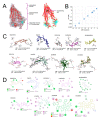Identification of Gedunin from a Phytochemical Depository as a Novel Multidrug Resistance-Bypassing Tubulin Inhibitor of Cancer Cells
- PMID: 36144591
- PMCID: PMC9501561
- DOI: 10.3390/molecules27185858
Identification of Gedunin from a Phytochemical Depository as a Novel Multidrug Resistance-Bypassing Tubulin Inhibitor of Cancer Cells
Abstract
The chemotherapy of tumors is frequently limited by the development of resistance and severe side effects. Phytochemicals may offer promising candidates to meet the urgent requirement for new anticancer drugs. We screened 69 phytochemicals, and focused on gedunin to analyze its molecular modes of action. Pearson test-base correlation analyses of the log10IC50 values of 55 tumor cell lines of the National Cancer Institute (NCI), USA, for gedunin with those of 91 standard anticancer agents revealed statistically significant relationships to all 10 tested microtubule inhibitors. Thus, we hypothesized that gedunin may be a novel microtubule inhibitor. Confocal microscopy, cell cycle measurements, and molecular docking in silico substantiated our assumption. Agglomerative cluster analyses and the heat map generation of proteomic data revealed a subset of 40 out of 3171 proteins, the expression of which significantly correlated with sensitivity or resistance for the NCI cell line panel to gedunin. This indicates the complexity of gedunin's activity against cancer cells, underscoring the value of network pharmacological techniques for the investigation of the molecular modes of drug action. Finally, we correlated the transcriptome-wide mRNA expression of known drug resistance mechanism (ABC transporter, oncogenes, tumor suppressors) log10IC50 values for gedunin. We did not find significant correlations, indicating that gedunin's anticancer activity might not be hampered by classical drug resistance mechanisms. In conclusion, gedunin is a novel microtubule-inhibiting drug candidate which is not involved in multidrug resistance mechanisms such as other clinically established mitotic spindle poisons.
Keywords: cancer; microtubuli; natural product; network pharmacology; targeted chemotherapy.
Conflict of interest statement
The authors declare that there is no conflict of interest.
Figures










References
-
- World Health Organization WHO traditional medicine strategy 2014–2024. 2013. [(accessed on 13 July 2022)]. Available online: https://apps.who.int/iris/bitstream/handle/10665/92455/9789241506090_eng....
MeSH terms
Substances
LinkOut - more resources
Full Text Sources
Medical

